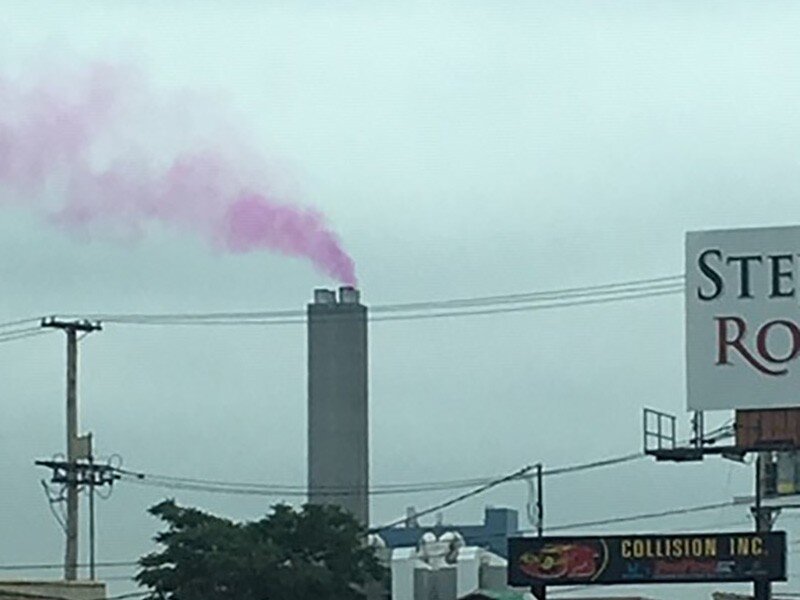
By Ana Isabel Baptista and Adrienne Perovich
The increased burning of household trash, a likely side effect of the Covid-19 pandemic, could well make an already desperate health situation in many Black and Latinx communities even worse.
Dirty industries are more often sited in communities of color with lax environmental protections and oversight. And as a recent widely reported Harvard University study concluded, a relatively small increase in particulate matter commonly part of airborne pollution is associated with a 15 percent increase in the Covid-19 death rate. This is almost certainly contributing to the disproportionately higher number of Covid-19 deaths in Black and Latinx communities.
One major contributor to this air pollution, including high amounts of particulate matter, is waste incineration. A study by the Tishman Environment and Design Center at The New School, with which we’re both associated, showed that almost all municipal solid waste incinerators – about 80 percent of them – are located within three miles or less of communities of color and low-income communities. You’ll find some of the largest such plants here in the Northeast: in Baltimore; Chester, PA (where much of Philadelphia’s waste is burned); and Newark. In fact, the incinerator in Newark’s Ironbound neighborhood (pictured below) burns refuse from more than 20 neighboring communities, including some trash from New York City.
Burning municipal waste – a mix of every material you can imagine, including plastics and metals – produces highly toxic emissions and byproducts including lead and mercury. Trash incinerators emit nitrogen oxide pollution, which is specifically linked to respiratory ailments including irritation of the nose, throat, and lungs. Carbon monoxide is also released, which contributes to ground-level ozone, a major trigger of asthma, as well as sulfur dioxide– a pollutant that can aggravate asthma, even with extremely limited exposure. Incinerators have also been found to emit six times more mercury, per unit of energy, than coal-burning energy facilities.
Even more shocking is the fact that state and local governments support this dirty industry with generous waste disposal contracts paid for by taxpayer dollars or through renewable energy subsidies. In order to cloak their image as polluters and qualify for renewable energy subsidies, incineration plants have rebranded themselves as “waste-to-energy” facilities. But incinerators in fact produce a negligible amount of energy and are considered among the most inefficient and expensive forms of energy generation along with being highly polluting. The contracts and subsidies given to the incineration industry hurts taxpayer wallets in the short term and the health of vulnerable populations over the long term.
For the last two years or so, cities across the United States have been burning more of their trash. That’s because China, long a major destination for American recyclables, decided that our recycling shipments were not sorted and cleaned sufficiently and began refusing to accept them. That has pushed up municipal waste collection costs, diverted recyclables to incineration, and caused many cities to wonder about continuing recycling at all.
Then came the pandemic. With millions of people suddenly spending virtually all of their time at home, the Covid-19 lockdown has produced a sharp increase in residential waste; by some accounts, municipal household refuse collections have grown by as much as 40 per cent.
At the same time, promising waste reduction programs have taken a hit. Before the Covid-19 pandemic, New York City, for example, planned to go citywide with its fledgling curbside collection of organic waste for composting. Now, with the pandemic-induced lockdown producing Depression-level unemployment and with City finances in a tailspin, the entire program has been deemed too expensive to maintain, and compostable materials will return or stay in a waste stream that ends in landfills and incinerators.
All that spells bad news for the communities that neighbor waste incinerators. The unfair burden that incinerators have long put on them, coupled with the sad news that there’s an increasing amount of trash being burned, means greater negative health impacts, including susceptibility to Covid-19 mortality for vulnerable residents.

Communities have resisted the siting of these dirty facilities for decades and will continue to do so, even as recent federal Environmental Protection Agency actions will almost certainly, and perversely, make the air we breathe dirtier. Many communities have won the closure of a waste incinerator, most recently in Detroit, where sustained, community-led opposition resulted in shutting down the Detroit Renewable Power facility in 2019.
The swath of tragedy caused by Covid-19 is difficult to comprehend and accept, especially the elements of human suffering and death that might have been avoided. We cannot let these deaths be in vain. This crisis is an opportunity to learn from our mistakes and radically change our business as usual approach to many systems – including the waste management system. State and local officials must reconsider any future incineration industry investment decisions through the lens of Covid-19 deaths. This pandemic is an opportunity to stop the dangerous practice of waste incineration and instead tackle the root of our waste problems through reduction, plastic bans, and organics diversion to prioritize the equal protection of public health.
Banner Photo by Paul W.
Other Photo by Christian Rodriguez/Ironbound Community Corp.
Ana Isabel Baptista, PhD., is director of the Tishman Environment and Design Center and Assistant Professor of Professional Practice at The New School, and Chair of Milano’s Environmental Policy and Sustainability Management program.
Adrienne Perovich, Master of Public Administration, is assistant director of the Tishman Center.
This post originally appeared in Urban Matters, a publication of the Center for New York City Affairs



